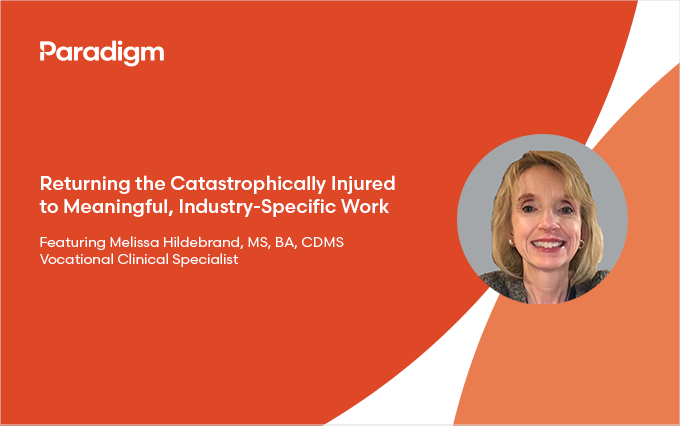06/02/2022

For any workplace injury, getting the injured patient back to their family, community, and work as quickly as possible is always the primary goal. The longer a person is out of work due to an injury or illness, the less likely they are to return to regular employment. And with catastrophic injuries, the barriers for a successful return to work are even more substantial. That’s why workers’ comp catastrophic care management with a dedicated focus on return to work can significantly decrease the length and cost of claims.
To achieve this, care management plans need to guide injured workers back to the purpose and structure of meaningful work—in a way that meets the unique features of their industry. With the vast majority of catastrophic injuries occurring in the construction, transportation, and manufacturing industries, effective vocational rehabilitation needs to be targeted to the specific challenges these injured workers are facing.
“I believe that working gives you a sense of identity,” said Melissa Hildebrand, MS, BA, CDMS, Vocational Clinical Specialist for Paradigm. “That’s why catastrophically injured workers should be getting a little piece of that back at each stage of recovery.” As a vocational rehabilitation specialist with deep experience working with catastrophic diagnoses in the major industries where they occur, Melissa understands the barriers to return to work in workers’ compensation, and how to help people overcome them.
Successful vocational rehab takes a team
In the vocational clinical specialist role, Melissa uses her broad experience to serve as a consultant and advisor to the vocational services counselors and the broader Paradigm Management Team. “It takes a lot of collaboration to move catastrophic cases forward,” she explained. “We meet frequently to keep these cases on track.
“In addition to the nurse case managers and vocational counselors, I may find myself working with a broader team. This can include Paradigm Medical Directors, Directors of Clinical Services, and our Community Support Specialists to ensure these patients receive all of the assistance and resources necessary to meet return-to-work goals.”
Creating an effective return-to-work rehabilitation plan
Each case is different, and outcomes depend on the diagnosis and severity of the injury. Because Paradigm achieves industry-leading return-to-work rates for catastrophic cases, a high number of outcome plans involve vocational services.
“There are a wide range of opportunities that we help injured workers engage with, from volunteering, to identifying interests, transferable skills and community resources, to helping develop resumes.” Melissa explained that it’s all about encouraging a return-to-work mindset from the very beginning.
Industry-specific solutions
“The majority of our referrals are in the construction, manufacturing, and transportation sectors.” Melissa emphasized the importance of helping these injured patients on a case-by-case basis and tailoring solutions that are most appropriate to a person’s occupational background.
“For example, in the transportation industry, injured commercial drivers have multiple options. Even if they are unable to resume work activities with a commercial driver’s license, they have transferable skills that can be used in an office role, or many transition to becoming other types of drivers, such as delivery drivers.
“In another case, we had a gentleman from Texas in the manufacturing industry with an amputation of one of the lower legs. I helped him research resources, develop a resume, and pointed him toward the Texas Workforce and development center,” she recalled. “So he went and met with a counselor and was eventually able to go back to work performing light manufacturing assembly.”
Overcoming obstacles to vocational rehabilitation
In many cases, vocational rehabilitation is as much about helping and encouraging injured workers as it is about getting a medical clearance or finding a specific work opportunity. “There are often mental barriers with these cases,” she said. “Maybe they’re resistant because they’re afraid or anxious and they don’t have a supportive family.”
Melissa went on to say that a big part is just listening to them and their concerns. “We find ourselves reassuring people that we’re not expecting them to get back to their job tomorrow. This is a process and we can take baby steps.” She continued, “But if someone wants to and is ready to work, it doesn’t matter if you’re quadriplegic; there’s definitely a job out there. In my experience, the most important part of the equation is motivation.”
Melissa also emphasizes the importance of Paradigm’s transitional return to work program. “Once a worker has been injured, they may need light duty that their primary employer is unable to provide,” she explained. “So we have relationships with nonprofit organizations and determine if they have a light duty transitional position available.”
The Paradigm difference for return to work
Paradigm’s comprehensive approach to vocational rehabilitation is built on a collaborative team-based structure that is backed by extensive case data. Vocational Clinical Specialists work closely with the Paradigm Management Team, to build focused and effective return-to-work plans. As Melissa puts it, “We’ve seen repeatedly that a day-one commitment to vocational goals gets people back to healthy, productive activity sooner, leading to shorter claims with significant cost savings and unparalleled return-to-work rates.”
Connect with us to learn about HERO CatastrophicSM, our full risk transfer and holistic care model for the most severe injuries, and Paradigm’s customized industry-specific solutions that return individuals back to work.